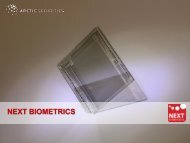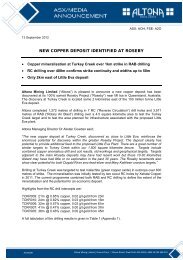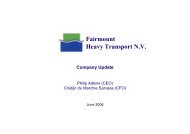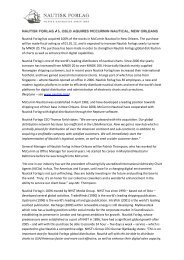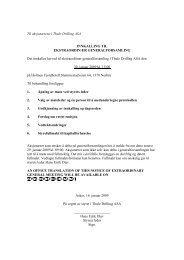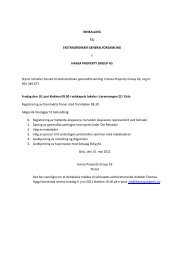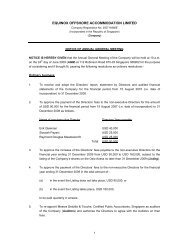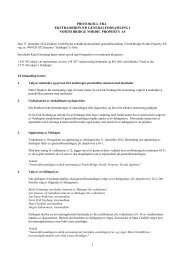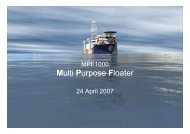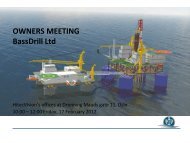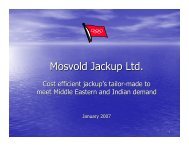Create successful ePaper yourself
Turn your PDF publications into a flip-book with our unique Google optimized e-Paper software.
Notes – Marine Subsea Consolidated<br />
establishes joint control over the economic activities of the entity.<br />
Investments in joint ventures are accounted for using the equity method<br />
of accounting and are initially recognised at cost.<br />
Unrealised gains on transactions between the group and its joint<br />
ventures are eliminated to the extent of the group’s interest in the joint<br />
ventures. Unrealised losses are also eliminated unless the transaction<br />
provides evidence of an impairment of the asset transferred. Accounting<br />
policies of joint ventures have been changed where necessary to ensure<br />
consistency with the policies adopted by the group.<br />
Dilution gains and losses arising in investments in joint ventures are<br />
recognised in the income statement.<br />
2.3 Operating segments<br />
An operating segment is a group of assets and operations engaged in<br />
providing products or services that are subject to risks and returns that<br />
are different from those of other operating segments. A geographical<br />
segment is engaged in providing products or services within a particular<br />
economic environment that are subject to risks and returns that are<br />
different from those of segments operating in other economic environments.<br />
The segment information is presented on the same basis as that<br />
used for internal reporting purposes.<br />
2.4 Foreign currency translation<br />
(a) Functional and presentation currency<br />
Items included in the financial statements of each of the group’s entities<br />
are measured using the currency of the primary economic environment<br />
in which the entity operates (‘the functional currency’). The consolidated<br />
financial statements are presented in USD. This is also the functional<br />
currency of all the significant subsidiaries in the Group.<br />
(b) Transactions and balances<br />
All transactions in currencies other than USD are included in the<br />
accounts at exchange rate on the date of the transactions. Foreign<br />
exchange gains and losses resulting from the settlement of such<br />
transactions and from the translation at year-end exchange rates of<br />
monetary assets and liabilities denominated in foreign currencies are<br />
recognised in the income statement.<br />
2.5 Vessels, rig and other equipment<br />
Vessels, rig and other equipment comprise mainly of multipurpose/<br />
intervention vessels, work accommodation barge vessels and semi<br />
submersiable. All vessels, rig and equipment are stated at historical cost<br />
less depreciation. Historical cost includes expenditure that is directly<br />
attributable to the acquisition of the assets.<br />
Subsequent costs are included in the asset’s carrying amount or recognised<br />
as a separate asset, as appropriate, only when it is probable that<br />
future economic benefits associated with the item will flow to the group<br />
and the cost of the item can be measured reliably. The carrying amount<br />
of the replaced part is derecognised. All other repairs and maintenance<br />
are charged to the income statement during the period in which they<br />
are incurred. Dry-docking expenses are capitalised as incurred and<br />
depreciated over the estimated useful life of the asset, i.e. until the next<br />
dry-docking. The carrying amount of the replaced part is derecognised.<br />
All other repairs and maintenance are charged to the income statement<br />
during the period in which they are incurred.<br />
Depreciation on assets is calculated using the straight-line method to<br />
allocate their cost less residual values over their estimated useful lives.<br />
Borrowing cost directly attributable to the aqusition or construction<br />
of a qualifying asset is capitalized as part of the cost of that asset.<br />
(note 2.20)<br />
The assets’ residual values and useful lives are reviewed, and adjusted if<br />
appropriate, at each balance sheet date.<br />
An asset’s carrying amount is written down immediately to its recoverable<br />
amount if the asset’s carrying amount is greater than its estimated<br />
recoverable amount (note 2.6).<br />
Gains and losses on disposals are determined by comparing the proceeds<br />
with the carrying amount and are recognised within ‘Other (losses)/gains<br />
– net’ in the income statement.<br />
2.6 Impairment of non-financial assets<br />
Goodwill and assets that are subject to amortisation are reviewed for<br />
impairment whenever events or changes in circumstances indicate that<br />
the carrying amount may not be recoverable. An impairment loss is recognised<br />
for the amount by which the asset’s carrying amount exceeds<br />
its recoverable amount. The recoverable amount is the higher of an<br />
asset’s fair value less costs to sell and value in use. For the purposes of<br />
assessing impairment, assets are grouped at the lowest levels for which<br />
there are separately identifiable cash flows (cash-generating units).<br />
These groups can not be on a higher level than the operating segments<br />
are divided into. Non-financial assets other than goodwill that suffered<br />
impairment are reviewed for possible reversal of the impairment at each<br />
reporting date.<br />
2.7 Financial assets<br />
The group classifies its financial assets in the following categories: at fair<br />
value through profit or loss, loans and receivables, and available-for-sale.<br />
The classification depends on the purpose for which the financial assets<br />
were acquired. Management determines the classification of its financial<br />
assets at initial recognition.<br />
(a) Financial assets at fair value through profit or loss<br />
Derivatives are categorised as held for trading unless they are designated<br />
as hedges. Assets in this category are classified as current assets.<br />
(b) Loans and receivables<br />
Loans and receivables are non-derivative financial assets with fixed or<br />
determinable payments that are not quoted in an active market. They<br />
are included in current assets, except for maturities greater than 12<br />
months after the balance sheet date. These are classified as non-current<br />
assets. The group’s loans and receivables comprise ‘trade and other<br />
<strong>Annual</strong> <strong>Report</strong> 2009 Marine Subsea 27



